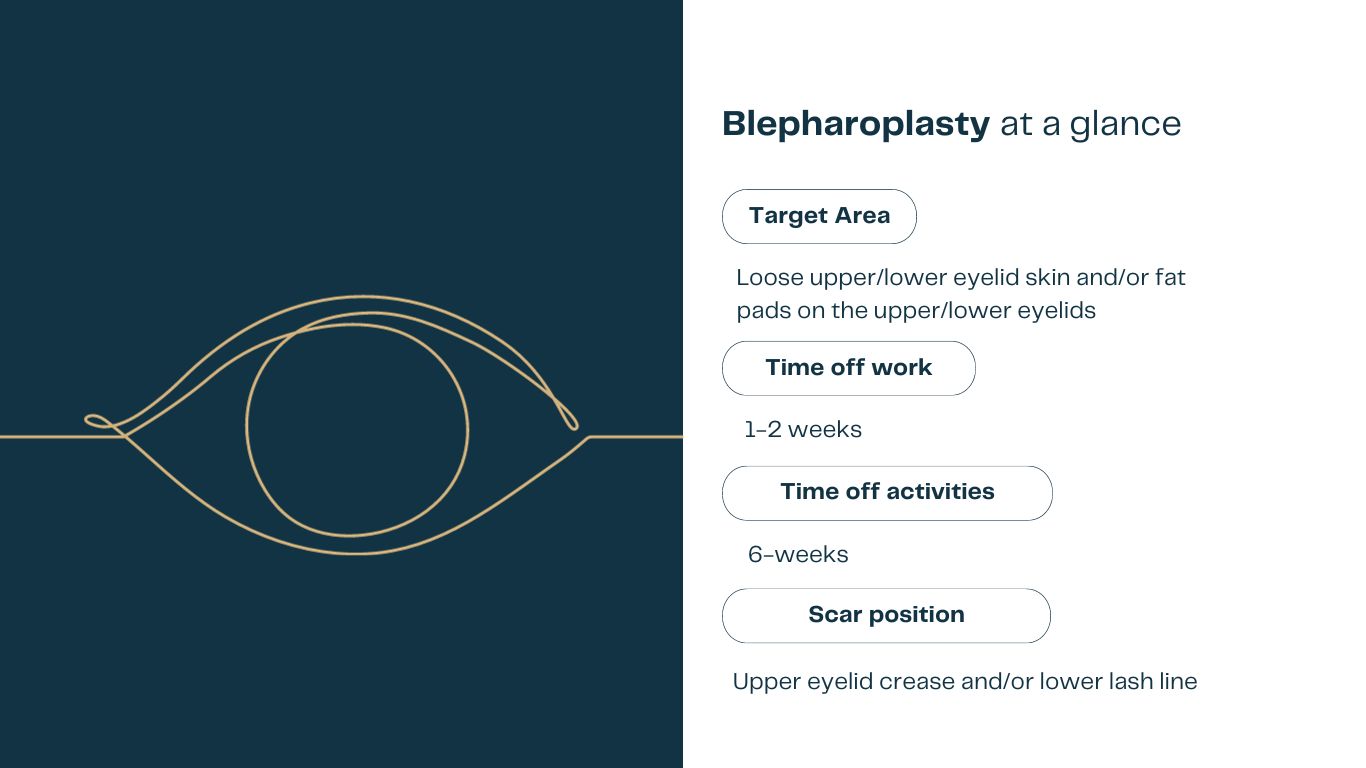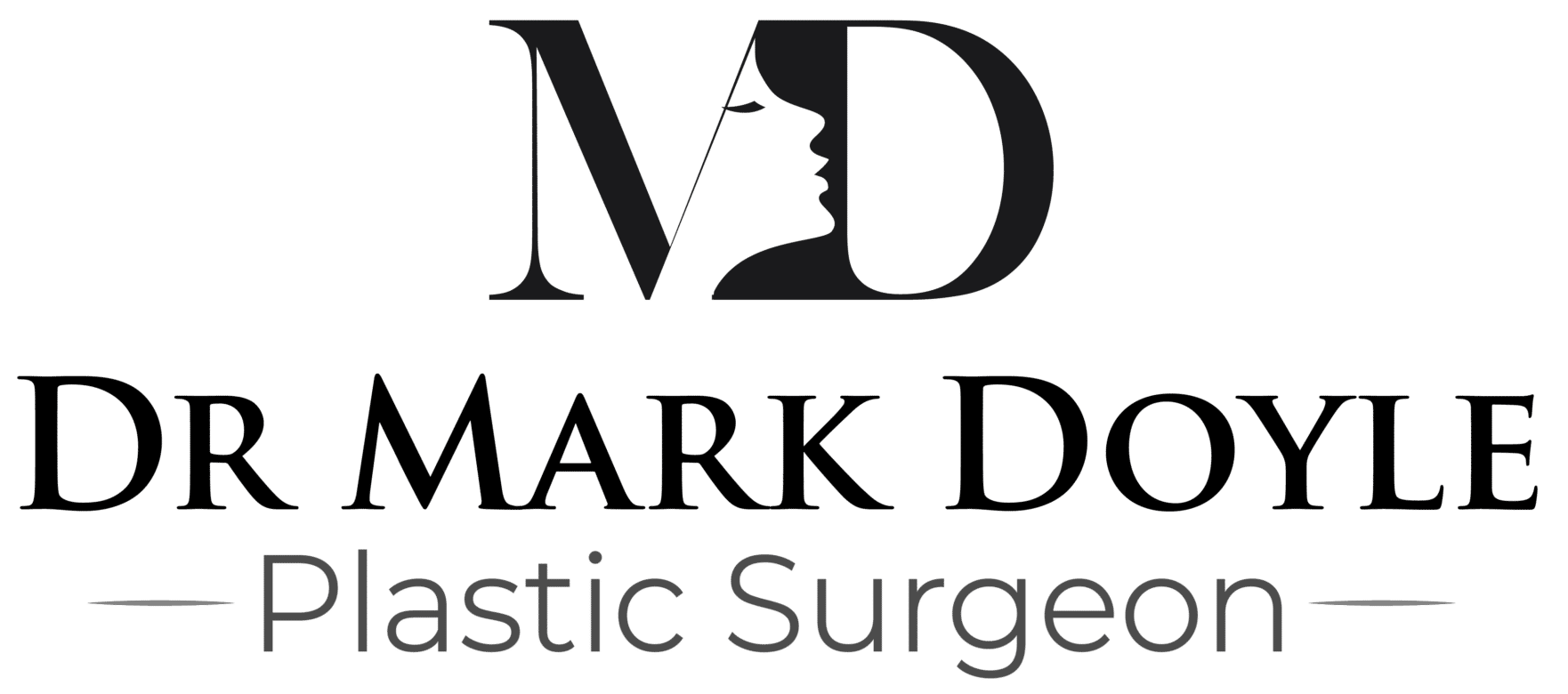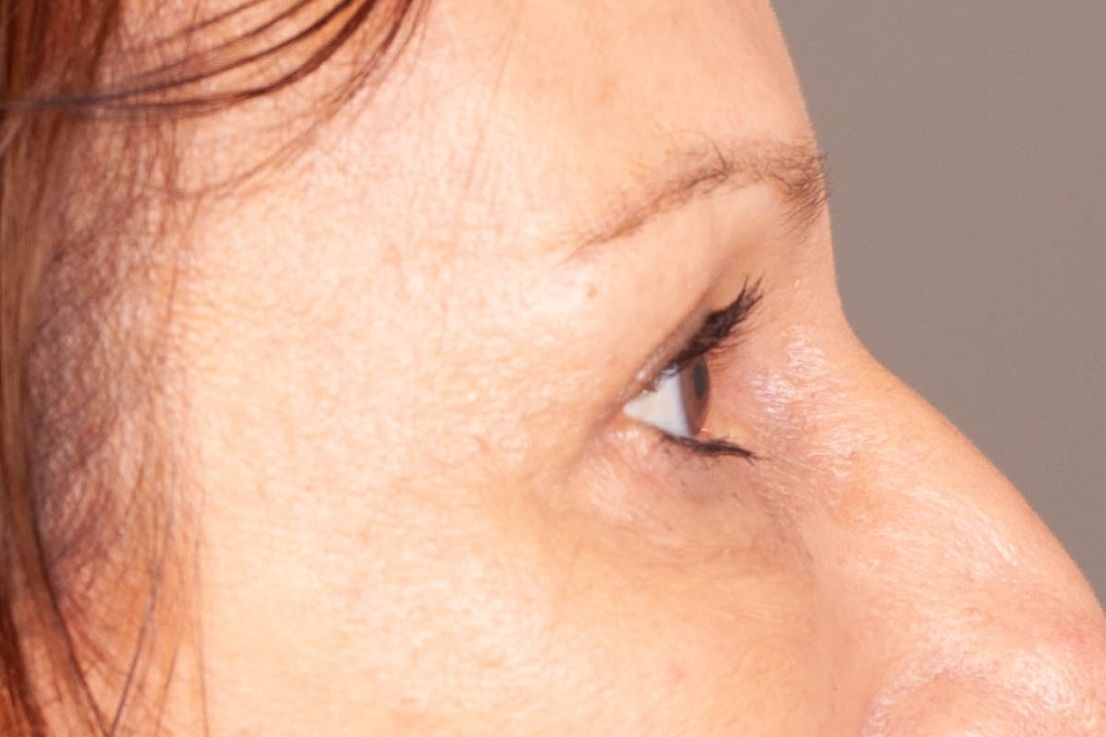Blepharoplasty (eyelid surgery) involves the careful removal or repositioning of excess skin, muscle, and fat from the upper or lower eyelids. With age, the skin around the eyes can lose elasticity and the muscles that support the eyelids may weaken, leading to changes in eyelid shape or function. Eyelid surgery may be performed on the upper eyelids, lower eyelids, or both, depending on individual anatomy and clinical assessment.
This procedure may be considered when excess skin on the upper eyelids interferes with vision. Blepharoplasty (eyelid surgery) can also address functional or anatomical concerns such as redundant eyelid folds or differences between the upper eyelids. Suitability for surgery can only be determined following a consultation and assessment by a qualified Specialist Plastic Surgeon.
The surgery itself is an outpatient procedure, meaning you can go home the same day. You may experience some bruising and swelling, and a full recovery can take 4 – 6 weeks.
Get a free virtual eyelid assessment by Dr Doyle today!

What Is Blepharoplasty?
Blepharoplasty (eyelid surgery) is a procedure that involves the removal or repositioning of excess skin, muscle, or fat from the eyelids. It may be performed on the upper eyelids, lower eyelids, or both.
Upper eyelid surgery may be considered when there is significant excess skin that affects the natural fold of the eyelid or impairs vision. In other cases, it may be performed to address changes in eyelid appearance related to ageing or anatomy.
Lower eyelid surgery may be used to remove or reposition excess skin or fat beneath the eyes. Suitability for either procedure depends on individual anatomy and the reasons for surgery, which should be discussed during a consultation with a qualified Specialist Plastic Surgeon.

Facial Rejuvenation
Blepharoplasty Results
An important consideration in blepharoplasty (eyelid surgery) is the placement of incisions to help minimise the visibility of scars. Incisions for upper eyelid surgery are typically positioned within the natural crease of the eyelid, while lower eyelid incisions are usually placed just below the lash line.
During surgical planning, careful assessment is made to determine how much skin can be safely removed. Removing too much upper eyelid skin can interfere with eyelid closure, so this is carefully evaluated as part of each patient’s surgical plan.
Different Types of Blepharoplasty
Upper Eyelid Lift
Upper blepharoplasty targets only the upper eyelid. It helps to reduce lines, excess skin, and concerns over a loose eyelids. Blepharoplasty surgery for loose eye skin may also improve vision that’s affected by excess upper eyelid skin.
Lower Eyelid Lift
Lower blepharoplasty can remove excess skin from the lower eyelids and can also focus on excess tissue removal. Also called eye tissue bag surgery, it can reduce lines and eye tissue bags.
Simultaneous Upper and Lower Eyelid Lift
Having both an upper and lower eyelid lift can reduce skin from the entire eye area. Combining these two procedures may be recommended.
Eyelid Surgery and Brow Lift
A brow lift may sometimes be performed in combination with eyelid surgery (blepharoplasty). In certain cases, elevating the brow can also improve the position of the upper eyelid skin, which may reduce the need for additional eyelid surgery. The decision to combine these procedures depends on individual anatomy and treatment goals and is determined following assessment by a qualified Specialist Plastic Surgeon.
Blepharoplasty Procedure
Eyelid surgery is done under general anesthesia at an accredited hospital. It usually takes 1 – 2 hours to complete.
The specific approach used in blepharoplasty (eyelid surgery) depends on whether the upper or lower eyelids are being treated.
For upper eyelid surgery, an incision is typically made within the natural crease of the eyelid to allow removal or repositioning of excess skin, muscle and fat before the incision is closed with fine sutures.
For lower eyelid surgery, a similar technique is used, with the incision placed just below the lower lash line. Both procedures are designed to address changes in the eyelid area caused by ageing or anatomy and are performed by Specialist Plastic Surgeon Dr Mark Doyle on the Gold Coast.
Recovery
Most patients report that they experience minimal pain and discomfort post-surgery. The time needed to recover depends on the type of procedure that you have.
Blepharoplasty recovery is usually pretty short and varies between each individual. Most people only need 1 – 2 weeks before they can return to work. During your recovery, you’ll likely experience some bruising and swelling around the eyes. This is a normal side effect and will subside within 2 – 3 weeks.
Full recovery can take anywhere between 4 – 6 weeks.
It’s important to take it easy for the first week or so and avoid strenuous activity. You should also sleep with your head elevated on pillows to help reduce swelling.
After a few weeks, you will be able to see the full results of your surgery. And, because the incisions are made in natural creases, scarring will generally be hidden.
Suitable Candidate
If you are considering eyelid surgery (blepharoplasty), it is important to have a clear understanding of what the procedure can and cannot achieve. Blepharoplasty can address excess skin or fat around the upper or lower eyelids, but it does not alter a person’s overall facial characteristics.
Suitability for this procedure depends on factors such as general health, eyelid anatomy and the reason for surgery. In some cases, upper eyelid surgery may also help improve vision if excess skin is obstructing the visual field. A consultation with a qualified Specialist Plastic Surgeon is required to determine whether this surgery is appropriate for you.
If you are considering blepharoplasty, schedule a consultation with Dr Doyle today.
Blepharoplasty Before and After
This gallery includes examples of eyelid surgery (blepharoplasty) performed by Specialist Plastic Surgeon Dr Mark Doyle. The images show outcomes achieved for individual patients and are provided for general information only. Results vary between individuals, and the appearance of scars and healing outcomes depend on factors such as anatomy, age, and recovery.
Dr Doyle is an experienced specialist plastic surgeon for eyelid lift surgery on the Gold Coast. He also performs eyelid lift surgery for Brisbane and Byron Bay patients, who travel specifically to see him.
Disclaimer: All information on the Dr. Mark Doyle website is general in nature and is not intended to be medical advice, nor does it constitute a doctor-patient relationship. Results can vary significantly and depend on individual patient circumstances. Please be aware that the outcomes shown are specific to those patients and may not necessarily reflect the results others may experience. Individual results can vary due to many factors, including genetics, diet, and exercise. All images on this website, unless specified as real patient images, are graphics used for illustrative purposes only. Surgery risks and complications will be covered in detail during a consultation with your surgeon. Book a consult for details regarding your cosmetic surgery procedure.
Blepharoplasty Gallery by Specialist Plastic Surgeon Dr Doyle
See all blepharoplasty before and after photos here.
FAQs
All surgical procedures result in some degree of scarring. In blepharoplasty (eyelid surgery), incisions are usually placed within the natural creases of the eyelid, which helps to make the scars less visible over time. The appearance of scars varies between individuals.
Yes, blepharoplasty can be combined with other surgery procedures such as a brow lift or facelift.
The most common risks associated with blepharoplasty are swelling, bruising, and infection. These risks are generally considered minimal and can be easily managed with medication. Other potential risks will be discussed during your initial consultation.
The changes achieved with blepharoplasty (eyelid surgery) are generally long-lasting; however, the natural ageing process will continue over time. Factors such as genetics, lifestyle, sun exposure and smoking can influence how the eyelids age after surgery. These factors may cause changes in skin elasticity and appearance over the years.
Blepharoplasty (eyelid surgery) is usually performed under general anaesthesia or sedation, meaning patients are not conscious during the procedure. Some discomfort, swelling or tightness may occur in the days following surgery. These effects are temporary and can generally be managed with prescribed pain relief and postoperative care as directed by your surgeon.
Yes. Eyelid appearance can vary between individuals based on anatomy and the amount of skin or fat tissue present. Some people have excess eyelid skin or a hooded fold, while others may have more prominent fat pads within the eyelids. These variations are normal and reflect individual differences in eyelid structure.
Loose or excess eyelid skin can develop with age as skin elasticity decreases and the muscles around the eyes weaken. In some cases, blepharoplasty (eyelid surgery) may be performed to remove or reposition excess skin, fat, and muscle tissue. The procedure may also assist with vision if overhanging eyelid skin is affecting the visual field. Suitability for surgery can only be determined following consultation with a qualified Specialist Plastic Surgeon.
There are many causes of dark circles under the eyes. These may include aging, genetics, sun damage, dehydration and poor sleep habits. In some cases, dark circles can be a sign of an underlying medical condition.
Blepharoplasty (eyelid surgery) does not specifically treat dark circles under the eyes. The procedure focuses on removing or repositioning excess skin, muscle, or fat from the eyelids. In some cases, changes in the eyelid structure after surgery may alter the way light and shadow appear around the eyes, but this varies between individuals.
How to get rid of under-eye excess tissue is a question Dr Doyle gets asked all the time. The best way to reduce excess under-eye tissue depends on the cause. If it is due to excess skin, then blepharoplasty may be a suitable option. However, if they are caused by dehydration or allergies, then simple lifestyle changes may be all that is required.
Puffiness or fullness under the eyes can result from factors such as ageing, genetics, fluid retention or changes in fat distribution. In some cases, lower eyelid surgery (blepharoplasty) may be considered to remove or reposition excess fat or skin in the lower eyelid area. The most appropriate treatment depends on the underlying cause, which can be assessed during a consultation with a qualified health practitioner or Specialist Plastic Surgeon.
Next Steps
Blepharoplasty (eyelid surgery) may be considered when there is excess eyelid skin or tissue. Suitability depends on individual anatomy and reasons for surgery and can be discussed during a consultation with Specialist Plastic Surgeon Dr Mark Doyle (FRACS).
To book a consultation, please call us on 5598 0988 or fill out our online enquiry form.
About Dr Mark Doyle FRACS (Plast) – Specialist Plastic Surgeon
Dr Mark Doyle is a Specialist Plastic Surgeon with over thirty years of experience. He specialises in face lift surgery in Gold Coast and Brisbane, and also offers a range of body and breast procedures.
Dr Doyle is a fully qualified Doctor and surgeon. He has completed all required training to be a Specialist Plastic Surgeon and is driven by an committed to providing excellent standards of care.
NEXT STEPS
Do Your Research
- Read the Website and Blogs relevant to your procedure
- Read our Frequently Asked Questions
- Learn about the Risks and Complications of Surgery
- Download our Plastic Surgery Guides
- Browse Dr Doyle’s YouTube Channel
What to Bring to Your Plastic Surgeon Consultation
- Bring a friend or relative for support and discussion regarding your choices
- Take notes and read all provided information thoroughly
- Read about what to expect in your Initial Surgery Consultation
Book Your Plastic Surgery Consultation
- Get a Referral from your GP or specialist – this is required to book a consultation with Dr. Doyle.
- Email us or call on 07 5598 0988 to arrange your consultation appointment.
- Pay your $300 Consultation Fee in advance to secure your consultation.
Please contact us to arrange to book a consultation with our Specialist Plastic Surgeon or to speak with our Patient Care Advisor.
Send an enquiry form today or phone 07 5598 0988 during Clinic Hours.
–
*DISCLAIMER: All information on Dr Mark Doyle website is general and is not intended to be medical advice nor does it constitute a doctor-patient relationship. Results can vary significantly and depend on individual patient circumstances. All images on this website, unless specified as real patient images, are stock images used for illustrative purposes only. Surgery risks and complications will be covered in detail during a consultation with your surgeon. Book a consult for details regarding your cosmetic surgery procedure.
Dr. Mark Doyle AHPRA Registration: Dr Mark Doyle MED0001375519 Specialist Plastic Surgery – MBBS FRACS FRCS





